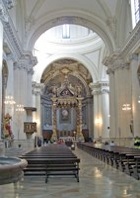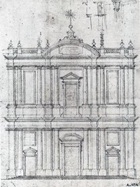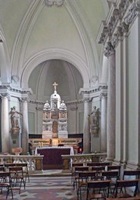
Portrait (18th century) of Giuseppe Piermarini
by Martin Knoller
Museo Teatrale alla Scala, Milan
Giuseppe Piermarini was born in Foligno in a house in what is now Via Pignatura. He moved to Rome in 1752 to study architecture under Carlo Murena.
He moved to Caserta in 1765 to work under Luigi Vanvitelli on the Royal Palace of King Charles VII of Naples, and the two men began an association that lasted until Vanvitelli’s death (in 1773). Thus, when the Emperor Joseph II commissioned Vanvitelli to remodel the Palazzo Reale in Milan in 1769, Piermarini took day-to day charge of the project and was appointed as the “Imperial Regio Architetto” of Milan. The importance of the project increased in 1771, when the Archduke Ferdinand, the brother of Joseph II and Governor of Lombardy, married Maria Beatrice d’ Este; the young couple intended to make the palace their principal residence. Piermarini and Vanvitelli found time to advise on the remodelling of the Duomo of Foligno (see below) during their trips between Naples and Milan in 1771-3. However, by the time that work on the palace in Milan actually began under Piermarini in 1773, Vanvitelli was dead.
Piermarini’s most important work in Milan was the construction of the Teatro alla Scala (1776-8). He also restored the Palazzo Brera and was appointed a professor of the Accademia di Brera, which was established there in 1776. He remained in the city until 1796, when it fell to Napoleon’s army. He then moved back to Foligno, where he spent the last 12 years of his life.
Foligno
Duomo


Work began on the restoration of the left transept in 1819, eleven years after his death but essentially to his designs (although advice was also sought from the Roman architect, Clemente Folchi).
Spello
Cappella del Sacramento (1793)




